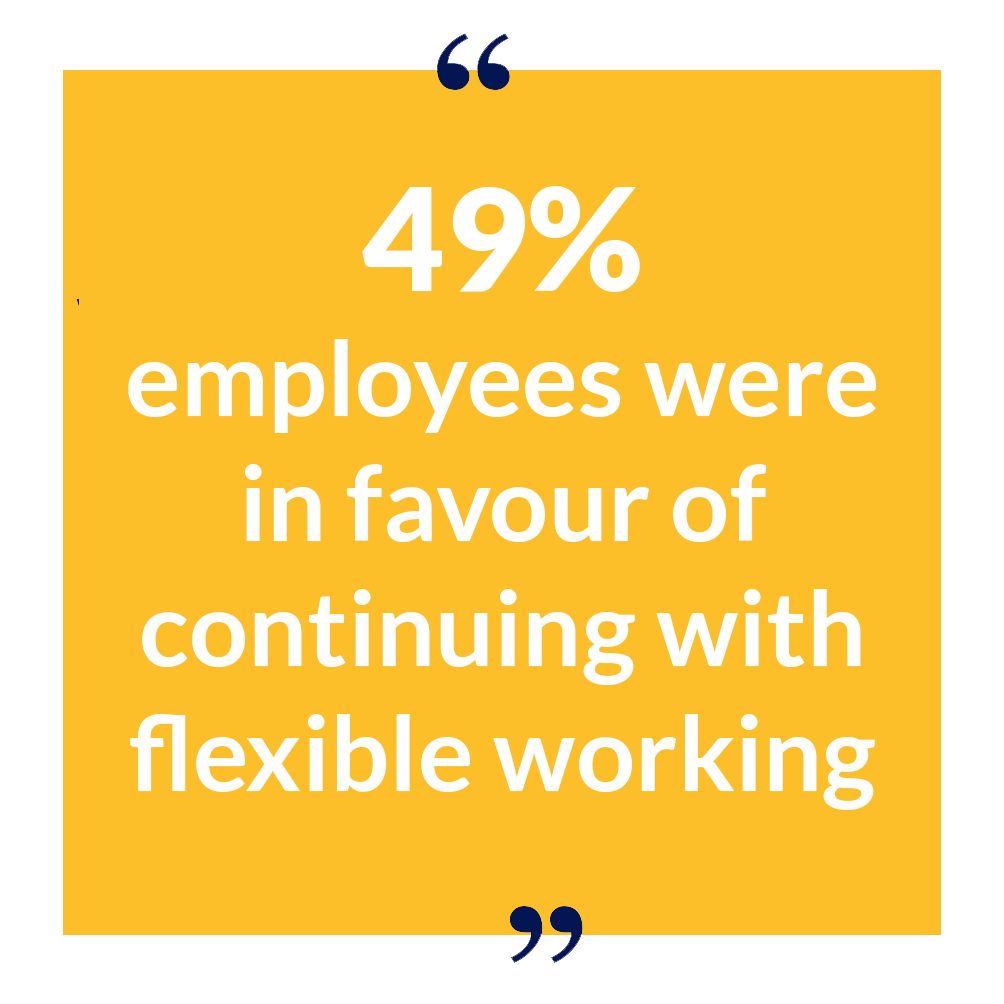As businesses emerge from their lockdown induced hibernation transitioning back to the office and strategic questions associated with it will be high on the agenda of many organisations. How will we tackle employee relationship management during this time?
Are we returning to the way we worked before, or adopting new ways of working?
The pandemic has changed work and employee expectations. For many, the question will not just be around ‘when’ do we return to work but rather ‘how’ do we return to work. Do we fully re-open offices or just partially? Are we expected to go back to the office full-time or just some of the time? You could revert back to pre-pandemic ways of doing business and for some companies (or departments) flexible working is not an option. But for most companies, thinking that we’ll all return to the office and working remotely will only happen for the minority of the workforce or in atypical circumstances is a legacy mindset focusing only on efficiency and not adaptability.

Hybrid challenges
Surveys show that nearly half of the population expect an increase in home working. A survey found that 47% people would find a new job if their employer didn’t offer hybrid work. So, companies that won’t accommodate remote working will not just be limiting their talent and recruitment pool but will potentially be losing talent to competitors who do.
But reduced face-to-face communication can create an ‘out of office’ ‘out of mind’ mentality which often leads to lower employee engagement. Lack of engagement might cause employees to become uninspired and de-motivated. From an employer’s perspective, a reduction in communication can also mean that workers are not being managed properly which can cause a vicious cycle
What can you do to improve employee relationship management?
We’ve researched the best ideas and considerations that cover this topic and pulled them all together as an actionable list. Of course, advice and legislation will be different according to geographical locations and might change as we progress through the government’s pandemic ‘roadmap’. So, it is important that all strategies take this into consideration and allow for any such modifications.
We focus on 5 strategies that feed into the key areas of business operations:
- Work (everything that surrounds the way we do things)
- Workforce (our people and talent, compensation, employee experience, talent processes)
- Workplace (physical environment)

1.SET CLEAR GOALS & OUTPUTS TO DRIVE WHEN, WHERE & WHO GETS WORK DONE
Research by the Boston Consulting Group highlights that over 40% of employees want flexibility when it comes to when and where they work. 60% of respondents say they want work flexibility along at least one dimension in the future.
A true hybrid workforce model focuses on employee relationship management, which is based on agreed goals between employees and employers, supported by a flexible, interchangeable approach to working onsite and remote depending on the context and details of the work. If you wanted to create highly tailored working models, connect to the employee experience and survey your people on how, when and where they get their work done.

2. OUTLINE HEALTH AND SAFETY
The Health and Safety Executive produced advice and guidance relating to Covid-19 which is a good starting point when considering post-Covid-19 health & safety measures. Culture plays an important role in health and safety in an organisation. Compliance is the backbone of employees relationship management in regards to feeling secure at work, and culture plays just a big part in this. Many different factors can contribute to whether a team member feels comfortable speaking up. e.g. raising health and safety concerns with their management, whether or not equipment is easy to understand, requesting training/education or, more importantly, discussing mental health issues. By considering these three points, you will ensure your team feel safe.
Needless to say, that risk management approaches, minimising the chances for infection and all health and safety activities should be in line with government guidelines. You can find sector-specific guidelines here. The CIPD recommends considering the following three key questions before bringing back people into the office.
- Is it essential?
In some cases, the return is going to be essential, and the employer needs to communicate this and give clear guidelines. As mentioned previously, whilst health concerns and risks remain significant, working from home should be supported. - Is it sufficiently safe?
As part of their duty of care obligations, whenever possible, employers should identify and mitigate risks to ensure that work premises are safe to return to. This would include workplace planning to accommodate social distancing, cleaning provisions and changes to working hours. - Is it mutually agreed?
A recent poll found that two in five people are anxious about returning to work. Employers cannot force their employees to return to work if it is unsafe. Understanding your employees and having open channels of communication with them is the only way we can identify concerns and take individual needs and worries into account.
3. INCLUSION AND EQUALITY
No single policy or program is likely to fit all circumstances and combinations of remote and onsite work. The BBC suggests that when it’s safe, one solution to preventing a divide between those in the office and those at home and stopping an ‘in-group & out-group’ dynamic from developing (not to mention inadvertently magnifying the gender gap with women often responsible for childcare) could be for all employees to be in the offices on a specific day.
A company’s culture communicates the values of the business and the way things are done but workforces split across different, and often remote, locations struggle to identify clearly what that culture means to them. When dealing with remote workers your key principles need to be clearly highlighted and accessible through digital communication platforms, in order to encourage the behaviours that align with those core values. A good diversity and inclusion strategy shouldn’t stop at just attracting diverse employees. Without the appropriate processes in place or ongoing support, after the hiring process, your employees will eventually leave. To successfully exhibit a culture that embodies a diverse & inclusive culture, you must include these components:
- Recognition
- Trust
- An intercultural point of view
And in order to truly embody this, your diversity & inclusion policy shouldn’t be a document that once created, is left to only be viewed as part of an onboarding process or to fulfil a box-ticking exercise. It is something that needs to be demonstrated daily, adopted at every part of the company process and communicated appropriately to your wider team.
4. EMPLOYEE EXPERIENCE IS PARAMOUNT TO EMPLOYEE RELATIONSHIP MANAGEMENT
But unleashing employee potential can only work if employees are not overworked, stressed or anxious. So, employee experiences have a new central focus. “Designing work for well-being”— how often would a phrase like this have been heard pre-pandemic? But we are now coming to the realisation that wellbeing and the value of the individual are what drives the most successful businesses. Here are some questions that will help build your strategy around employee experiences and wellbeing for when we transition into the new normal:
- What kind of wellbeing initiatives do we have? Are they a ‘programme’ or ‘resources’? How can we embed wellbeing into our company culture and business operations? (This includes physical and mental health, workplace safety, inclusion and diversity, and even career and rewards.)
- What channels do we have to actively communicate any tools or benefits to employees that support themselves and their families?
- What culture embedding mechanisms do we have in place that help amplify wellbeing?
- What mechanisms do we have to connect with our employees? Do we have employee surveys in place?
- How do we reward and recognise employees?
5. DIGITAL ASSISTANCE
How can we leverage innovations for transitioning back to work? Although the implementation of the use of digital technologies was on the rise even prior to the Covid-19 outbreak, organisations looked at these tools as something ‘good to have’ as opposed to supporting employee relationship management. The pandemic has created a mindset shift where digital technologies have become essential for our day-to-day work. With the inevitable arrival of hybrid work the pressure HR professionals and line managers face juggling and managing several tasks and responsibilities at once, will include the added complexities of remote working and people not being on-site. However, there are certain initiatives that can help with decreasing admin tasks and workload.
- Automating HR processes
- Automating HR processes can streamline workflows, ensure processes are consistent, reduce the likelihood of error, and can help HR save time and money which can be better spent on strategic people initiatives. If there are any upcoming performance reviews, new starters, leavers, or key dates, HR software can remind HR teams and appropriate employees (such as line managers) about these events by sending automatic alerts such as e-mails, in App notifications and even notifications in Microsoft Teams. Various stages of the recruitment process and payroll can also be automated.
- Digitising the employee experience
- Managing time and attendance can be a long process. Digitizing such employee processes can save time and effort for managers and HR professionals. But beyond this, research shows that fast and transparent communication and allowing employees to perform their tasks efficiently tends to result in greater employee experiences.
- Access to information
- One of the biggest differentiators between a business just surviving or thriving, is its ability to adapt and pivot when necessary. The ability to make data driven strategic decisions is a key driver of organizational adaptability. But here’s the kicker. Inaccurate or out-dated data leads to mistaken decisions. For example, knowing which departments or individuals performed well last year doesn’t mean they perform well right now, under a different set of circumstances in a world disrupted. That’s why the importance of real-time data became prevalent for future planning and success.
- Leveraging AI
- Specific ways to utilise AI for HR:
- AI backed chatbots: chatbots can provide human like and ‘always-on’ communication tools that can help keeping employee engagement going and answer the most frequent questions relating to returning to work
- Recruitment: AI has successfully augmented the task of candidate screening
- Onboarding: AI can be utilised to highlight company policies and answer employee questions during the first days of onboarding Learning and Development: AI can tailor the learning experience and modify training courses to suit the student’s learning as the course unfold
- Specific ways to utilise AI for HR:
Ensuring positive employee experiences
Remote work is here to stay and as such, transitioning back to the office should take this into account. Connecting with and surveying your employees can provide data when it comes to determining work design and location and organisation specific actions. On the other hand, technological innovations can act as enablers of dialogues with your team. They can provide the tools for streamlining and developing processes that suit both traditional and hybrid work approaches and will result in a positive employee experience.





